American air defense forces, aviation reconnaissance and control systems deployed in Japan
In the comments to the article on modern Japanese fighters, some readers expressed the opinion that the multiple superiority of the Air and Naval Self-Defense Forces of Japan over our Far Eastern 11th Air Force and Air Defense Army and the Red Banner Pacific fleet does not matter, and in the event of an armed conflict, we will destroy the enemy with nuclear weapons.
In fairness, it should be said that our country really possesses the world's most powerful tactical nuclear weapons, and this is in many ways a sobering factor for any aggressor. However, one must understand that for a number of reasons, using tactical missiles, aviation Free-fall bombs and torpedoes, equipped with "special" warheads, the Russian armed forces can really only in neutral waters or on their own territory to repel Japanese aggression.
Anyone who declares that we will easily burn all Japanese combat aircraft at home airfields in the flames of nuclear explosions, and destroy the ships of the Naval Self-Defense Forces along with the infrastructure of naval bases and, in general, simply with the help of "Caliber" and "Iskander", and also other "Poseidons" with "Zircons" we will turn the Japanese islands into a lifeless radioactive desert or even send them to the seabed, forgetting that between Japan and the United States for 60 years there has been a "Treaty on mutual cooperation and security guarantees."
Under this treaty, the United States is obliged to cooperate with the Japan Self-Defense Forces in maritime safety, assist in ballistic missile defense, assist in securing air borders, coordinate domestic air traffic, secure communications, and participate in disaster relief. As part of this agreement, many American military bases have been deployed in Japan, on which airplanes, helicopters, ships, radar stations, air defense missile systems, marines' barracks, numerous warehouses and points of material and technical supply are deployed on a permanent basis, communication centers and reconnaissance centers operate.
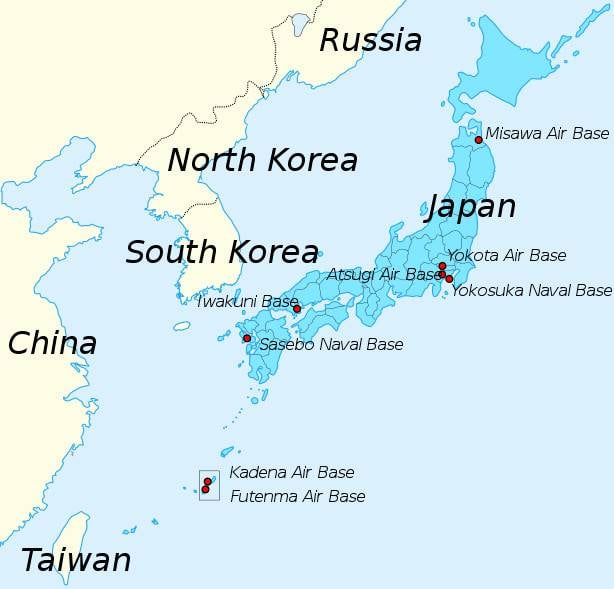
Layout of large American military bases in Japan
With a high degree of probability, the Americans will not directly get involved in an armed conflict with Russia and, most likely, will not directly provide armed support to the Japanese in offensive actions, if they suddenly decide to use military force to reclaim the "northern territories". But it is worth remembering that there are about 90 American military personnel, civilian specialists and their families in the Japanese Islands, as well as 000 large bases and more than 8 American defense facilities, and our attack on Japan will inevitably affect the military and US citizens. Given that an attack on American military bases will certainly be viewed as an act of war, the use of Russian nuclear weapons across Japan will put the world on the brink of nuclear disaster.
Air Defense Forces of the 5th Air Army, US Air Force
The main potential enemy of the Russian Aerospace Forces in the Far East is considered the US Air Force Command in the Pacific Air Force, with its headquarters at Hickam airbase (Oahu, Hawaii). Subordinate to the Pacific Command are the 5th (Japan), 7th (Republic of Korea), 11th (Alaska) and 13th (Hawaii) air armies.
Currently, the headquarters of the US armed forces in Japan is located at Yokota Air Force Base in the vicinity of Tokyo, which is shared by the US and Japanese military. The command of the American 5th Air Army, which is the air component of the American military contingent, is also stationed at the Japanese Yokota airbase. At the same base, there is the central command post of the Air Self-Defense Forces, the headquarters of the Air Defense Command of the Self-Defense Forces and key elements of the Japanese JADGE air defense system.
The 5th Air Army, stationed on the Japanese islands, includes: the 35th Fighter Wing (Misawa Airbase) and the 18th Task Force (Kadena Airbase). These two aviation divisions have over 130 aircraft and helicopters.
The Misawa Air Base, located in the northern part of Honshu Island, is divided by the 35th Fighter Wing of the United States Air Force and the 3rd Tactical Fighter Squadron of the Japanese Air Defense Forces (F-2A / B and F-35A Lightning II fighters, as well as the T-4 trainer) ... It is reported that close cooperation has been established between the Japanese and American fighters. At the same time, the Americans are not on constant duty to ensure the inviolability of the airspace of Japan, do not rise to meet the violating aircraft, and basically make training flights. But, in the event of an aggravation of the situation, the US Air Force, together with its allies, must protect Japanese targets from air strikes.
The 13th and 14th Squadrons of the 35th Fighter Wing have a total of 48 single-seat F-16CJs and two-seat F-16DJ fighters of the Block 50P modification.
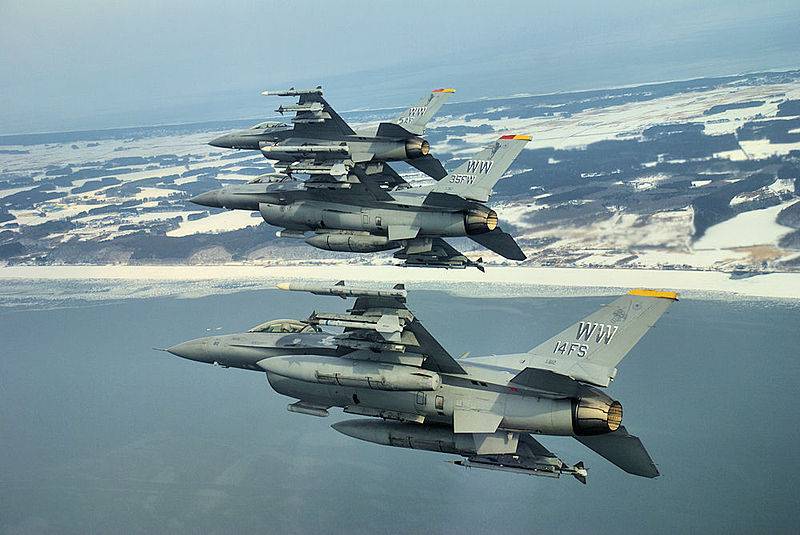
F-16CJ / DJ fighters of the 14th Fighter Squadron Fighting Samurai
These aircraft were originally intended to combat enemy radar and air defense systems and carry AGM-88 HARM and AGM-158 JASSM guided missiles. However, in addition to hitting ground and surface targets, the pilots of the Fighting Falcons, based in Japan, actively train in close combat and practice intercepting air targets against which they can use the AIM-9 Sidewinder and AIM-120 air-to-air missiles. AMRAAM.
A significant proportion of the pilots of the 35th Fighter Wing have combat experience. In the past, the 13th and 14th squadrons were transferred to other airbases and participated in the provision of no-fly zones in Iraq and in anti-terrorist operations in the Middle East.
The largest American military facility located in Japan is the Kadena airbase, on about. Okinawa. The airbase has two asphalt-concrete runways, each 3688 meters long, on which aircraft of all types can land. It is the largest and most actively used US Air Force base in East Asia. The number of American military personnel, their families and civilian specialists working here is estimated at approximately 20000.
Kadena Air Base, where the main components of Task Force 18 are deployed, is home to US Air Force 18 Wing, Special Operations Group 353, 82nd and 390 Reconnaissance Squadrons, 1st Battalion, 1st Artillery Regiment Air defense and many auxiliary units. Frequent guests at the airbase are the 5th generation F-22A Raptor fighters stationed on a permanent basis in Hawaii. Currently, about 80 aircraft and helicopters are permanently located at the Kadena airbase, but if necessary, taking into account the territory, available shelters, parking areas and ready infrastructure, the airbase is able to receive more than 200 aircraft without additional preparation.
The 18th wing is considered the base unit, and today it is the largest and most diverse wing of the United States Air Force in terms of aircraft types. The basis of its combat potential is the 44th and 67th fighter squadrons, equipped with F-15C / D heavy fighters (36 units in total).
Currently, the American and Japanese "Eagles" (9th Air Wing of the Southwest Air Defense Command), stationed at the nearby Naha airbase, provide air defense for Japan from the south.
During the development of the strengthening of American forces in the region, aviation units not assigned to the 18th air wing were repeatedly transferred to the Kadena airbase. Satellite images show that in the past, F / A-18C / D, F-22A and F-35A fighters were repeatedly located at the largest American airbase in Japan.
F-2017A fighters can be seen in the pictures taken in 2018-35 at the airbase parking lots. According to information published in American sources, these aircraft belong to the 4th Flying Fuujins Fighter Squadron, which is part of the 388th Tactical Wing.
Reconnaissance and airspace control facilities available in Okinawa
The airspace on the approaches to Okinawa is controlled by a Japanese stationary radar post on Mount Yaedake (western part of Okinawa), a Japanese stationary radar post on Okinawa. Okinoerabu, a Japanese radar post on the island. Miyakojima and the American AN / TPS-77 mobile radar, deployed in the northern part of the Kadena airbase. Air traffic control in the near zone (up to 56 km) is carried out according to the AN / MPN-25 radar data.
The 961st control and air control squadron is armed with E-3В / С Sentry AWACS aircraft (four units), upgraded to the Block 40/45 (E-3G) level. In reality, three aircraft can carry out patrolling. One E-3G is usually undergoing repair and maintenance.
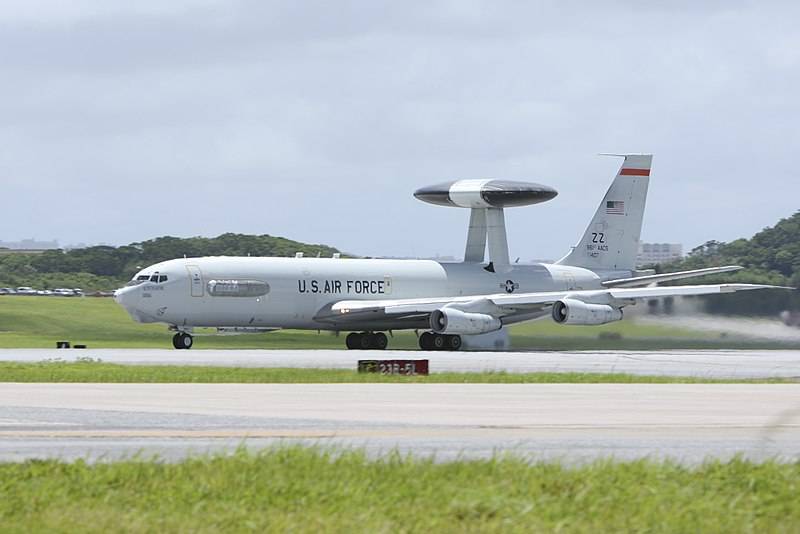
Aircraft AWACS E-3 at Kadena airbase
American AWACS aircraft most often patrol along the Chinese coast, from Taiwan to the Korean island of Jeju. There are cases when flying radar pickets, taking off from the Kadena airbase, without entering the airspace of neighboring countries, made non-stop flights along the coast of the PRC, North Korea and Russia. The fuel supply on board the E-3G aircraft allows you to stay in the air without refueling for 10 hours. A single AWACS aircraft patrolling at an altitude of 9000 meters can control an area of 300 km². The detection range of a low-altitude target with an RCS of 000m² against the background of the earth in the absence of interference is 1 km. Patrolling is usually carried out at an altitude of 400-8500 meters at a speed of 10000 km / h.
In addition to detecting air targets, pointing fighters at them and issuing target designation to ship and ground air defense systems, modernized aircraft of the AWACS system have electronic reconnaissance equipment that provides frequency measurement, amplitude direction finding and parametric recognition of the type of intercepted radiation source.
According to data published in open sources, the RTR onboard station is capable of identifying more than 500 types of ground, ship and aircraft radars. The station, operating in the frequency range 2-18 GHz, provides 360 ° circular scanning and direction finding of radio emission sources with an error of no more than 3 ° at a distance of 250 km. Its performance is approximately 100 recognition of radiation sources in 10 s. The maximum operating range of the RTR station of the E-3G aircraft by powerful signal sources exceeds 500 km.
Thus, American AWACS aircraft deployed at Kadena airbase can not only be used to detect sea and air targets and direct combat aircraft to them, but are also a fairly effective means of collecting intelligence information.
Long-range reconnaissance is also carried out by aircraft of the 82nd reconnaissance squadron: RC-135V / W Rivet Joint, RC-135S Cobra Ball, RC-135U Combat Sent. The processing of information received by the crews of E-3G AWACS and RC-135 V / W / U / S reconnaissance aircraft is carried out by specialists of the 390th reconnaissance squadron (non-flying), which is directly subordinate to the US Air Force Intelligence and Surveillance Agency, and is also responsible for cryptographic protection communication channels.
There are 4 strategic scouts permanently at the Kadena airbase. All aircraft of the RC-135 family are built on the basis of the C-135 Stratolifter transport aircraft, which, in turn, has much in common with the passenger Boeing 707.
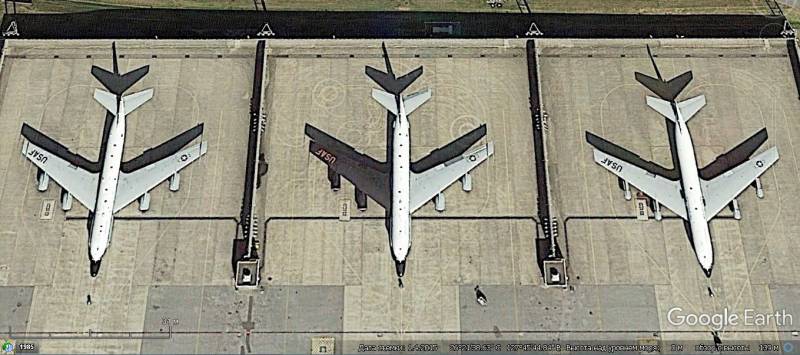
Satellite image of Google Earth: reconnaissance aircraft RC-135V / W, RC-135S and RC-135U at Kadena airbase
Currently, the most common US Air Force reconnaissance aircraft created using the C-135 Stratolifter airframe is the RC-135V / W Rivet Joint. The RC-135V long-range reconnaissance aircraft have been upgraded from the RC-135C Big Team configuration. RC-135W were built on the basis of transport C-135B. This is the only difference between the V and W variants, they both carry the same reconnaissance equipment. Reconnaissance RC-135V / W externally differ from C-135 Stratolifter transport aircraft and air tankers by numerous antennas and an elongated black nose cone.
The main purpose of RC-135V / W scouts is to intercept radio signals and direction finding of radio emission sources. The suite of equipment on board allows the crew to detect, identify and locate signals across the entire electromagnetic spectrum. The collected information can be transmitted in real time via satellite and radio channels to a wide range of consumers.
The RC-135S Cobra Ball aircraft is equipped with optoelectronic systems and telemetry interception equipment. It is primarily designed to monitor ballistic missile launches and warheads on the descending flight. Initially, these aircraft, taking off from the Kadena airbase, were intended to track the target field of the Kura training ground in Kamchatka. However, the RC-135S is also currently overseeing Chinese and North Korean missile tests.
Aircraft of this modification are very easy to identify visually. To avoid glare that could "blind" the optoelectronic equipment, the top of the right wing and the inner parts of the nacelles of the right engines are painted black. On the starboard side of the RC-135S there are four enlarged windows designed for optoelectronic reconnaissance. During the upgrade to the Cobra Ball level, the aircraft that remained in service received an onboard multifunctional synthetic aperture radar, which provides tracking of the flight of ballistic targets in high cloud conditions.
Long-range reconnaissance aircraft RC-135U Combat Sent is designed to collect information about radars and anti-aircraft missile guidance stations and deployment locations. The data collected during reconnaissance flights are taken into account when planning air strikes and are used in the development of new or in the modernization of existing radar radiation receivers, electronic warfare equipment, decoys, anti-radar missiles and simulators.
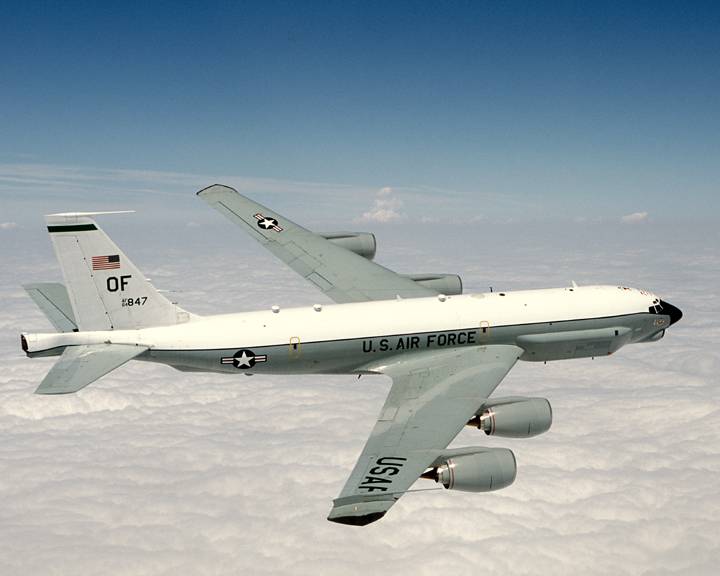
RC-135U Combat Sent
Unlike the RC-135S and RC-135V / W, the RC-135U radio reconnaissance aircraft does not have a black-painted elongated nose. Instead, a characteristic "beard" of the antenna fairing is observed in the lower nose.
The characteristics of all RC-135s are about the same. The maximum takeoff weight of the RC-135V / W is 146200 kg. The maximum speed is 930 km / h. Cruising speed at an altitude of 9100 m - 853 km / h. The ceiling is 130000 m. The flight range without refueling is 5500 km. Maximum crew size: 2 pilots, 2 navigators, 14 reconnaissance operators, 4 electronic warfare operators and 4 flight engineers.
On board the RC-135 V / W / U / S reconnaissance aircraft there is a very sophisticated equipment for setting up active jamming, designed to counter air, sea and ground radars, suppress channels of combat control and guidance of anti-aircraft and air missiles, as well as a device for shooting heat traps and dipole reflectors.
Tanker aircraft supporting the operations of the US Air Force aircraft based in Japan
To support the actions of fighters, flying radar pickets and long-range reconnaissance aircraft at Kadena airbase, there are KC-135R / T Stratotanker tanker aircraft belonging to the 909th refueling squadron.
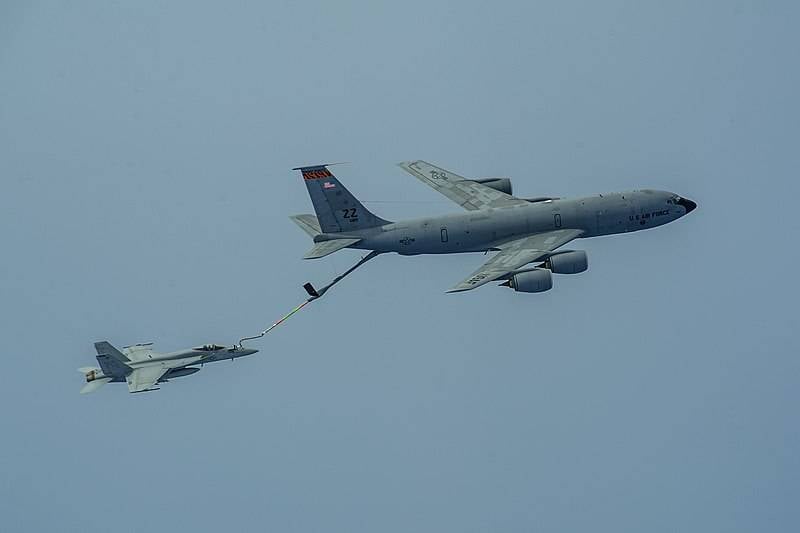
The KC-135R refueling aircraft from the 909th refueling squadron refueling the F / A-18E fighter
During the exercise, air tankers also practice refueling the F-16C / D of the 35th US Air Force Fighter Wing from the Misawa base, F / A-18C / D - the Marine Corps, F / A-18E / F - the aviation wing of the nuclear aircraft carrier "George Washington "and Japanese F-15Js from the Naha base. During the execution of refueling missions, the American KC-135R / T, taking off from the Kadena airbase, make intermediate landings at the Japanese Yokota airbase, Thai - Korat, Singapore - Changi and Australian - Darwin. In total, twelve air tankers are permanently stationed at the Kadena airbase.
Although the KC-135R / T are not combat aircraft, their role in providing air defense for American bases located in Japan is very important. The ability to transfer aviation fuel on board fighters patrolling at a considerable distance from their airfields and AWACS radar aircraft on patrol significantly increases their time in the air and pushes back the lines of interception.
Initially, KC-135 tankers were intended to support the actions of bombers of the Strategic Air Command, but from the late 1960s they were adapted for refueling tactical and carrier-based fighters. The flight data of the KC-135R / T is the same with the RC-135V / W reconnaissance aircraft. A tanker aircraft with a maximum takeoff weight of 146 kg takes 284 kg of kerosene on board. The ferry range is 90718 km. When transporting 17700 kg of aviation fuel, the range is 68000 km. Crew: 2400 pilots, navigator and refueling equipment operator.
Management of units of the 5th Air Force of the United States Air Force and coordination with the Japanese Air Self-Defense Forces
An important link between the command of the 18th US Air Force Task Force, stationed on the island of Okinawa, the headquarters of the 5th US Air Force Air Force and the central command post of the Air Self-Defense Forces, located at Japan's Yokota Air Force Base, is the 623rd Operations and Communications Squadron.
In 2011, against the background of North Korean missile tests, the improvement of the control system of the American air defense / missile defense forces deployed in Japan began. As part of ensuring the functioning of the DVIDS system (English Spartan Shield, the art of air and missile - operations to control the fire of anti-aircraft weapons and air defense aviation), the staff of the 623 squadron was increased and its technical re-equipment.
In January 2019, the C2 equipment of the TORCC system was put into operation. The TORCC system (Theater Operationally Resilient Command and Control) is a data fusion mechanism that combines monitors for visualizing the current tactical situation, a command and control center, a virtual air defense system integrator, a complex and a unit for linking transmission and reception channels of information from other command posts, radar posts, AWACS aircraft, fighter-interceptors and anti-aircraft missile batteries.
The 623rd Squadron is tasked with maintaining stable communications and real-time data exchange with the 5th Air Force Command of the US Air Force and the Self-Defense Forces Air Defense Command Center. For this, a communications center is used, located on the territory of the Japanese airbase Naha.
American Patriot PAC-3 long-range air defense systems deployed in Japan
In February 2006, four Patriot PAC-3 SAM batteries of the 1st Battalion of the 1st Air Defense Artillery Regiment were transferred to Kadena airbase from Fort Bliss (Texas) to protect against North Korean ballistic missiles. Currently, two air defense systems are on constant combat duty in the vicinity of the American air base.
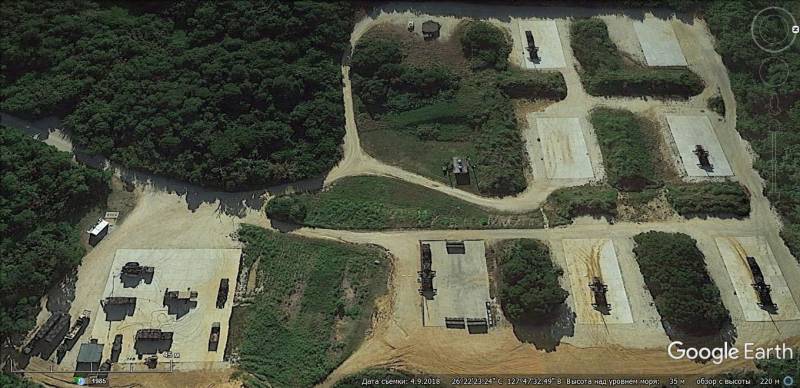
Satellite image of Google Earth: the position of the Patriot PAC-3 air defense system in the vicinity of the Kadena airbase
The batteries, deployed at Kadena base, are part of the 38th Air Defense Brigade, headquartered at Sagami Base, Kanagawa Prefecture (40 km south of Tokyo).
Airbases of the USMC in Japan
US Marine Corps Air Station Futenma is located seven kilometers south of Cadena Air Force Base. About 3000 marines, the 1st KMP Aviation Wing and a number of auxiliary units are stationed here. The runway 2740 m long and 45 m wide can accommodate all types of combat and transport aircraft, including the heaviest ones.
Although only helicopters and tiltrotors and units of the 18th Marine Air Traffic Control Group are currently permanently stationed at Futenma Air Station, in the recent past, the AV-8B Harrier II and F / A-18C / D Hornet Marine aircraft landed here.
The main purpose of these combat aircraft is to provide air support during amphibious operations, as well as strike at sea and ground targets. But, in addition to these tasks, the US ILC aviation pilots are practicing close air combat and interception. In addition, the F-15C / D runway of the 44th and 67th Fighter Squadrons of the US Air Force is considered as a reserve runway for the Futenma airbase.
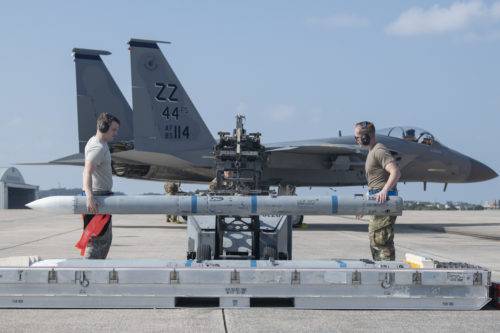
Preparing for the departure of the 15th Squadron F-44C fighter at the USMC Futenma air station
To control the airspace around the Futenma air station, the squadrons of the naval air traffic control group have AN / TPS-59 and AN / TPS-80 radars at their disposal. They are not on constant duty, they are turned on when an increased combat readiness is announced and during training. Air traffic control in normal conditions is carried out according to data broadcast from Japanese stationary radar posts and the AN / MPN-25 radar deployed at Kadena airbase.
The main force of the US KPM combat aircraft in Japan is located at Iwakuni Air Force Base in Yamaguchi Prefecture. This facility is used in conjunction with the Japanese Maritime Self-Defense Forces, which operate US-2 flying boats, P-3C base patrol aircraft, UP-3D and EP-3C reconnaissance aircraft, and AW101 minesweeper helicopters.
As of 2020, there were about 5000 American military personnel and their families living in the vicinity of Iwakuni Air Base. Iwakuni is assigned to the 12th Marine Corps Aviation Group, which includes the 242nd Assault Naval Fighter Squadron, armed with the F / A-18C / D Hornet, and the 121st Fighter Assault Squadron, flying the F-35B Lightning II (the first deployed combat squadron F-35B).
In 2014, the 152nd naval transport and refueling squadron equipped with KC-130J aircraft was relocated from Futenma to Iwakuni, which significantly increased the combat radius and time spent on patrols for F-35B, F / A-18C / D and F / A-18E / F stationed at Japanese airfields.

Air tanker KC-130J, next to it F-35B and F / A-18C / D fighters
The maximum take-off weight of the KC-130J is 79379 kg, the capacity of the fuel tanks is 25855 kg. The maximum speed is 670 km / h. Cruising - 640 km / h. The service ceiling is 8700 m. Although the range of the KS-130J is significantly inferior to the KC-135R / T tankers, this modification of the Hercules, in contrast to the Stratotanker, is much less demanding on the length and condition of the runway and is more versatile.
If necessary, in addition to refueling, the KC-130J can carry 19000 kg of payload, 64 armed paratroopers or 2 M113 armored personnel carriers. In 2010, the US ILC installed the Harvest Hawk weapon system on the KC-130J, which includes AN / AAQ-30 optoelectronic sighting and search equipment, Hellfire or Griffin missiles, and a 30-mm cannon.
Deck fighters and AWACS aircraft based in Japan
The Yokosuka Naval Base is home to the USS Ronald Reagan (CVN-76), a forward-based nuclear-powered aircraft carrier, part of the 5th Aircraft Carrier Strike Group, US 7th Fleet. This group also includes six Arleigh Burke-class destroyers and three Ticonderoga-class cruisers. Usually, together with an aircraft carrier, there are 3-4 American destroyers and cruisers in the harbor, as well as 1-2 multipurpose nuclear submarines.
When repelling an air attack, American cruisers and destroyers located at the Yokosuka naval base will certainly use their air defense means.
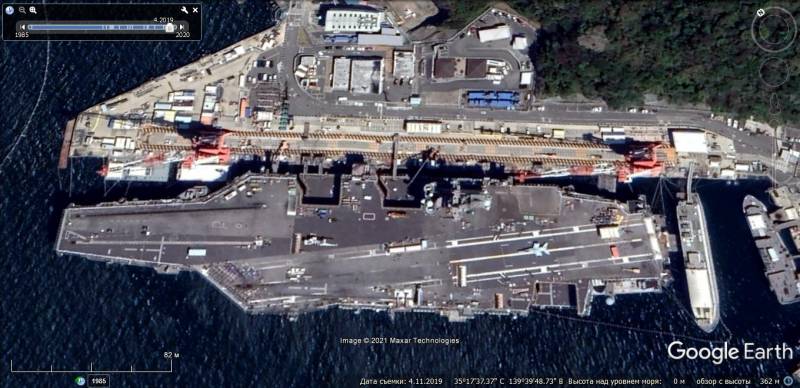
Satellite image of Google Earth: aircraft carrier USS Ronald Reagan (CVN-76) at the Yokosuka naval base
While the aircraft carrier "Ronald Reagan" is at the Yokosuka naval base, most of its air wing is located at Atsugi Air Force Base, in Kanagawa Prefecture, which
is the largest American naval aviation base in Japan. The runway length is 2438 m.
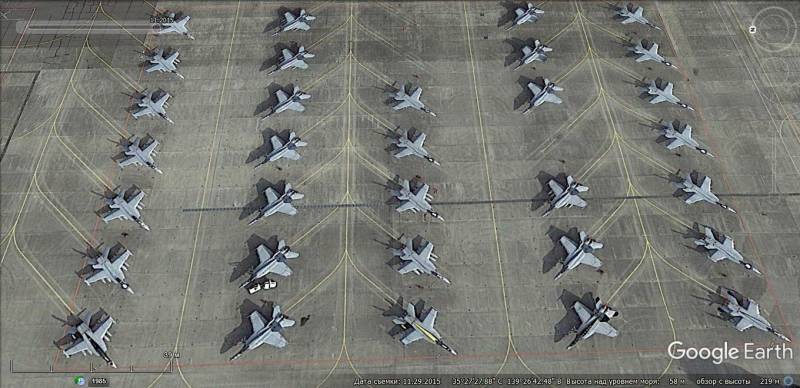
Satellite image of Google Earth: F / A-18E / F fighters and EA-18G electronic warfare aircraft at Atsugi airbase
Since 2017, nine squadrons of the 5th aircraft carrier wing are based here, which are armed with carrier-based AWACS aircraft E-2D Advanced Hawkeye, electronic warfare EA-18G Growler, fighters F / A-18E / F Super Hornet, carrier-based transport aircraft C-2 Greyhound and SH-60 / MH-60 Seahawk helicopters.
The Super Hornet fighters are in service with four strike fighter squadrons: 27th, 102nd, 115th and 195th. Pilots of the 141st Electronic Assault Squadron use EA-18G Growler jammers. Airspace control at distant approaches and fighter guidance is carried out by the crews of the 125th aircraft carrier squadron of radar warning of E-2D aircraft. It is reported that the technical serviceability of aircraft of the 5th aircraft carrier wing is about 75%.
While at the Atsugi airbase, Super Hornet fighters are included in the duty forces, and AWACS carrier-based aircraft regularly fly out on patrols. Currently, carrier-based fighters of the Navy and KMP (approximately 80 F / A-18E / F), based on Japanese airfields, are not equipped with equipment for interfacing with the TORCC combat control system, which makes it difficult to use them in conjunction with F-16CJ / DJ and F- 15C / D. Commands of target designation for air targets in an automated mode, they can receive from deck aircraft AWACS E-2D and voice over the radio.
Possible scenario of using American fighters in the event of an armed conflict between Japan and Russia
Currently, up to 200 US Air Force and Navy fighters are permanently stationed in Japan, which is almost twice the number of Russian fighters deployed throughout the Far East. Taking into account the fact that more than 120 airfields with capital coverage have been built on the Japanese islands, it is possible to disperse (20-24 aircraft per airfield) over 1300 combat aircraft.
Do not discount other American forces stationed in the Far East within walking distance of Japan. Only taking into account 78 F-16C / D fighters of the 51st Fighter Wing and 36th Fighter Squadron, which are part of the 7th US Air Force, stationed in South Korea at the Gunsan airbase, the advantage of the Americans in fighter aviation over the Russian 11- the Air Force and Air Defense Army will be more than 2,5 times.
The US Air Force command can also transfer part of the forces of the 11th American Air Force from Alaska. Its most combat-ready units are: the 3rd Fighter Wing, which includes two 90th and 525th fighter squadrons on F-22A fighters, the 354th Fighter Wing equipped with the F-16C / D, and the 962nd Radar Air Group. patrol and control of E-3C.
At Andersen Air Force Base (Guam), under the control of the 36th Air Wing, the F-15C and F-22A fighters provide air defense. Without taking into account the combat aviation of Japan and South Korea, as well as the combat aircraft deployed to this area by the American airmen, more than 400 American fighters of the Air Force, Navy and USMC based on land airfields can be operatively involved against Russian aviation. Their actions will support up to 10 AWACS aircraft and approximately 30 tanker aircraft.
The multiple local numerical superiority of Japanese and American fighter aircraft is aggravated by the deplorable state of the airfield network in the Russian Far East. The very small number of operational hard-surface runways severely limits our ability to build up an aviation grouping at the expense of combat aircraft airlifted from the western and central regions. It should also be understood that we are still very much inferior in high-precision long-range aviation weapons that do not carry "special" warheads. This, in turn, limits our ability to destroy aircraft and destroy the infrastructure of enemy airfields without entering the enemy air defense zone.
Taking into account all these factors, it can be predicted that, in the event of an armed confrontation between Japan and Russia, when the Russian Aerospace Forces uses only conventional aviation weapons of destruction, American fighters, interacting with the Air Self-Defense Forces, are able to provide air defense of key Japanese objects and minimize damage from our retaliatory strikes.
The ending should ...
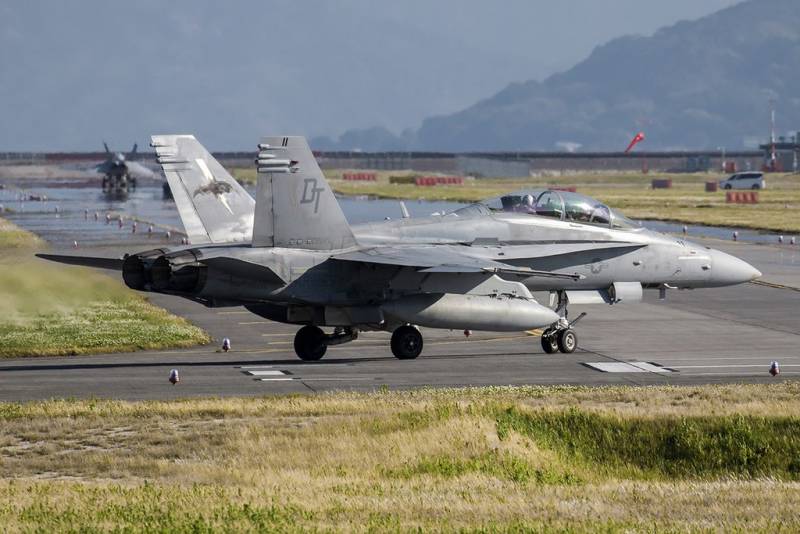
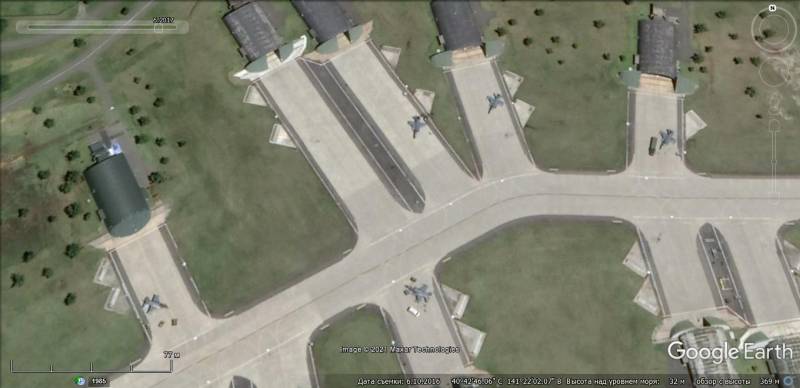
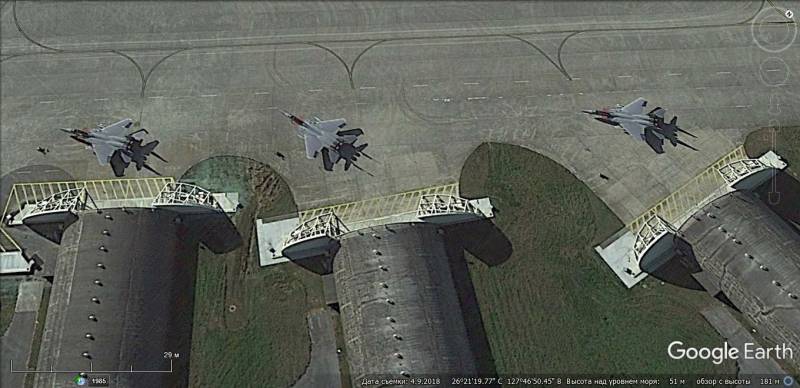
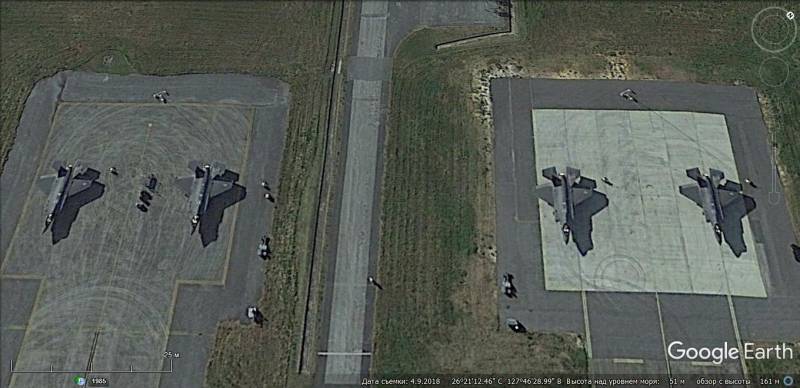
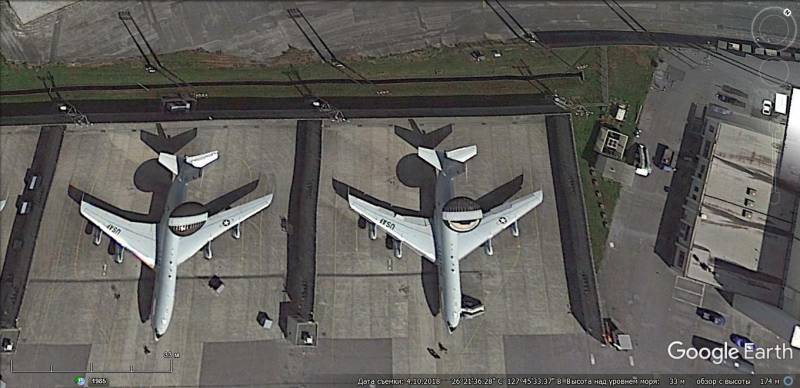
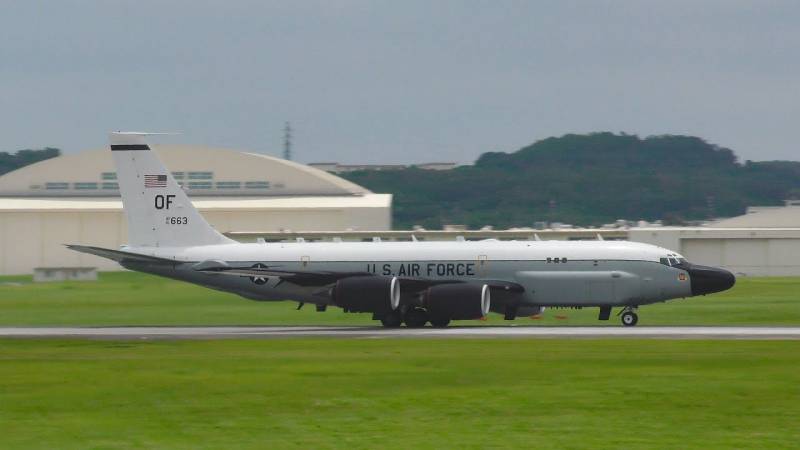
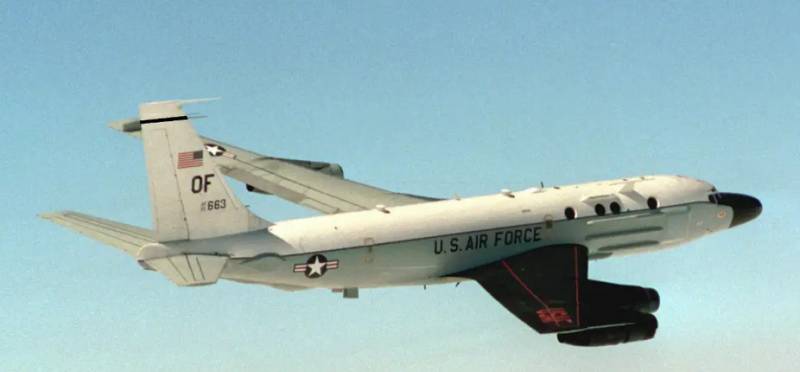
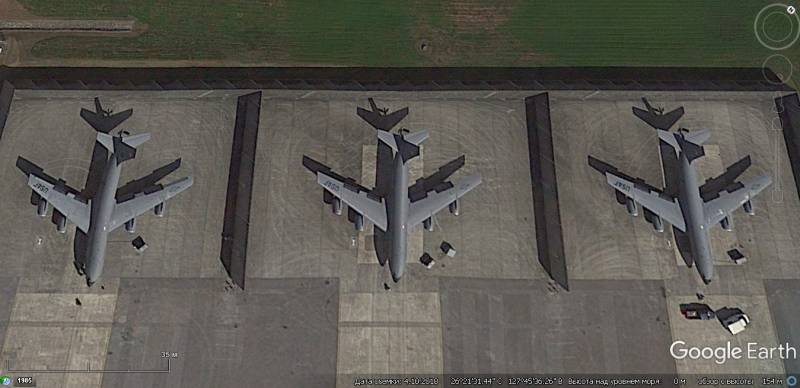
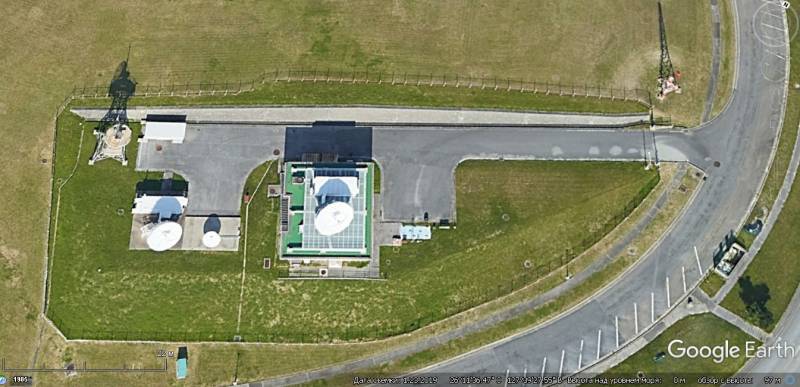
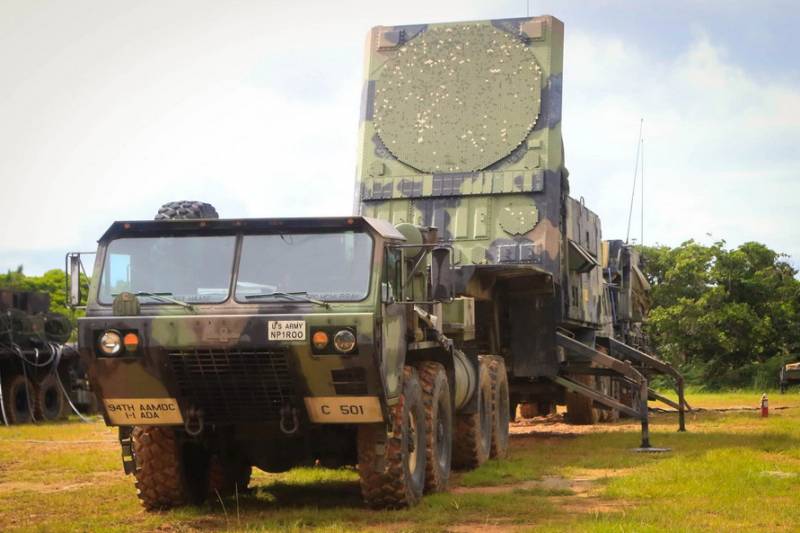
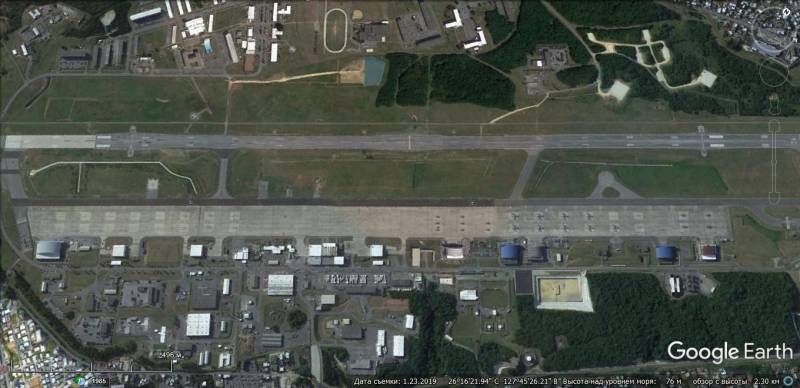
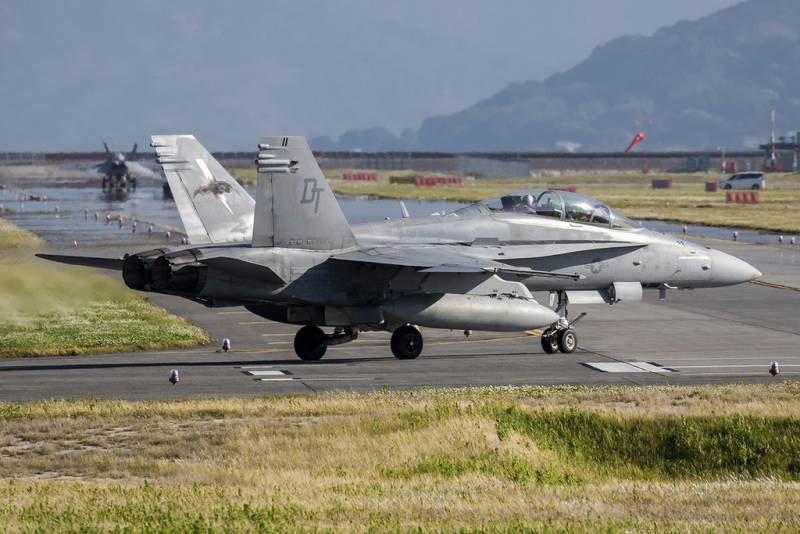
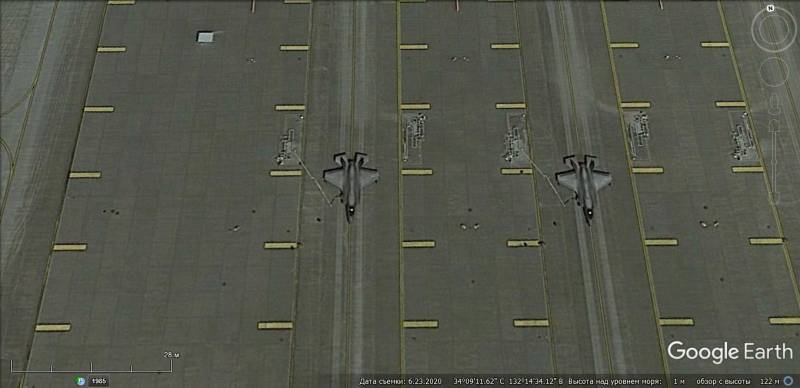
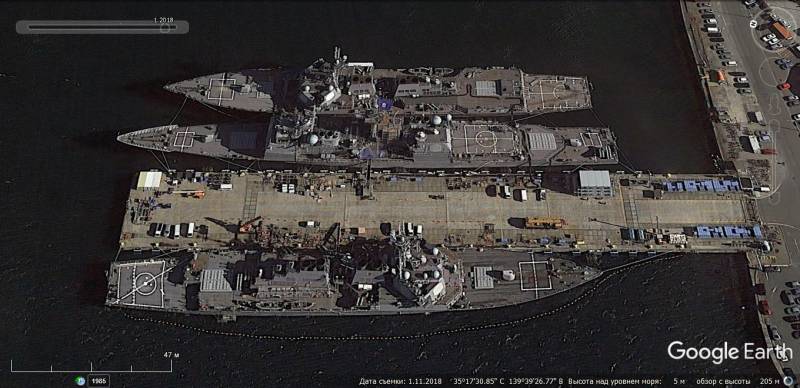
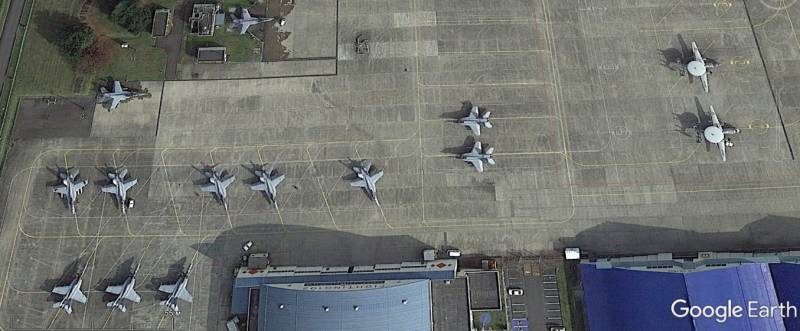
Information